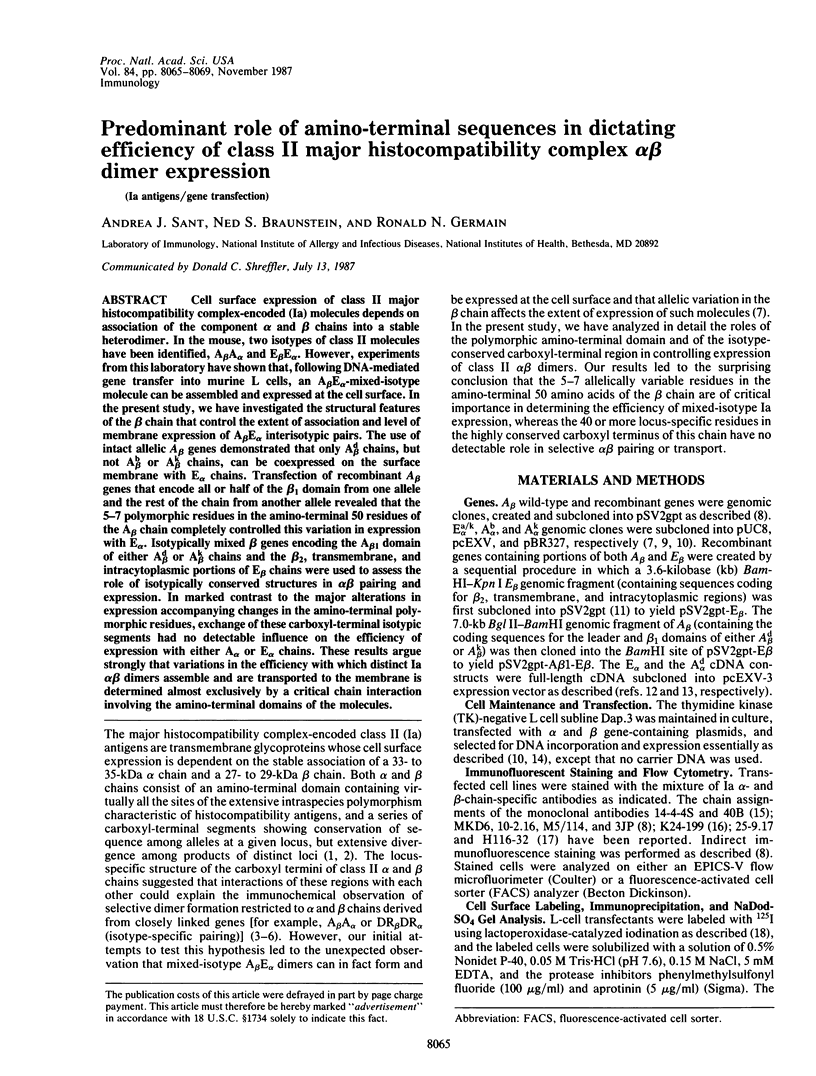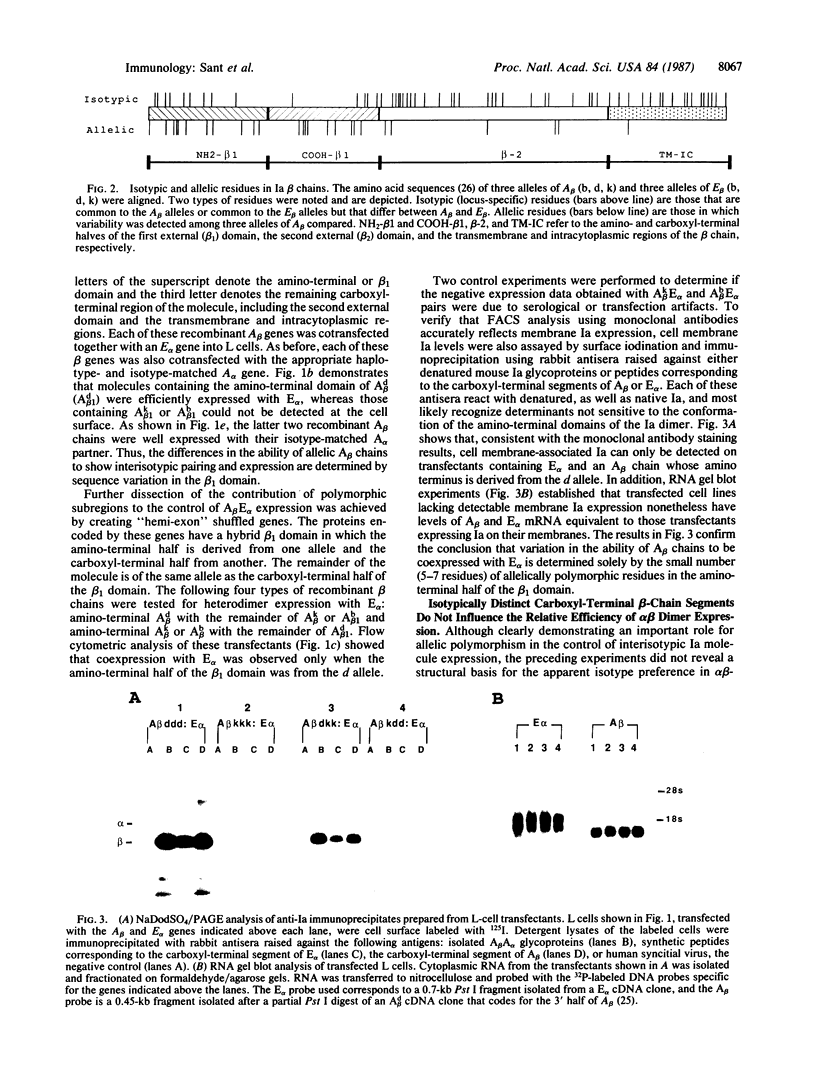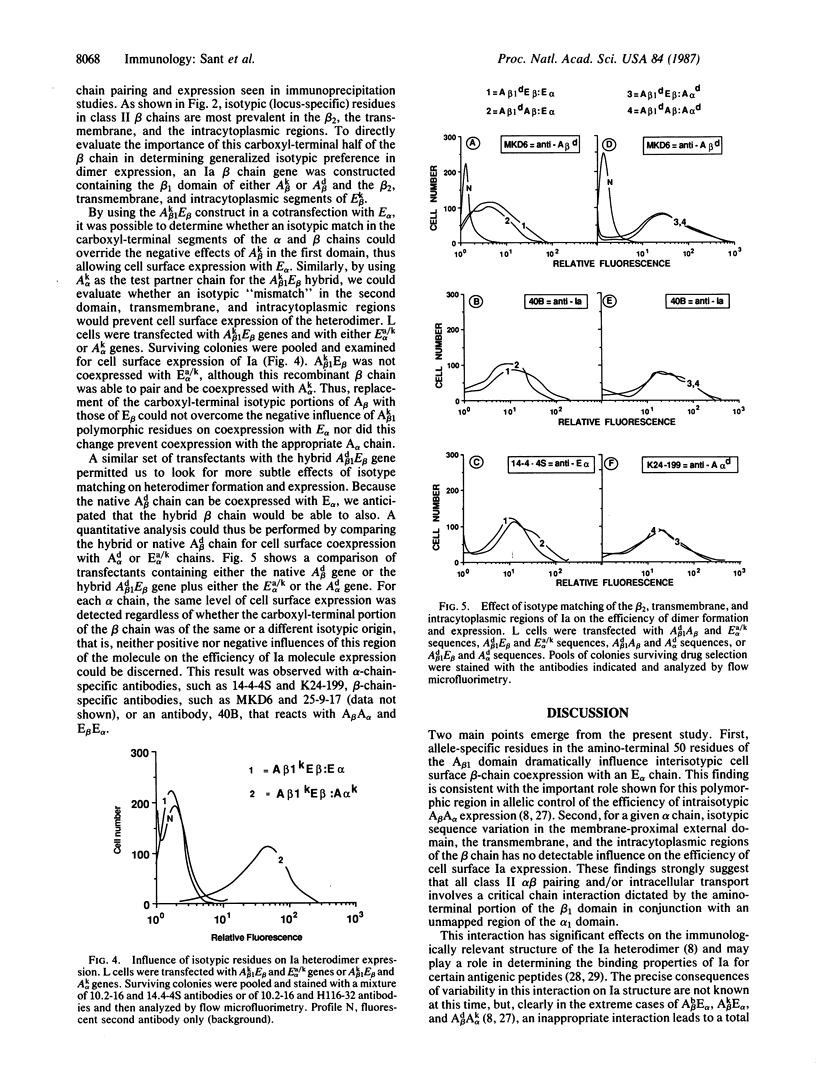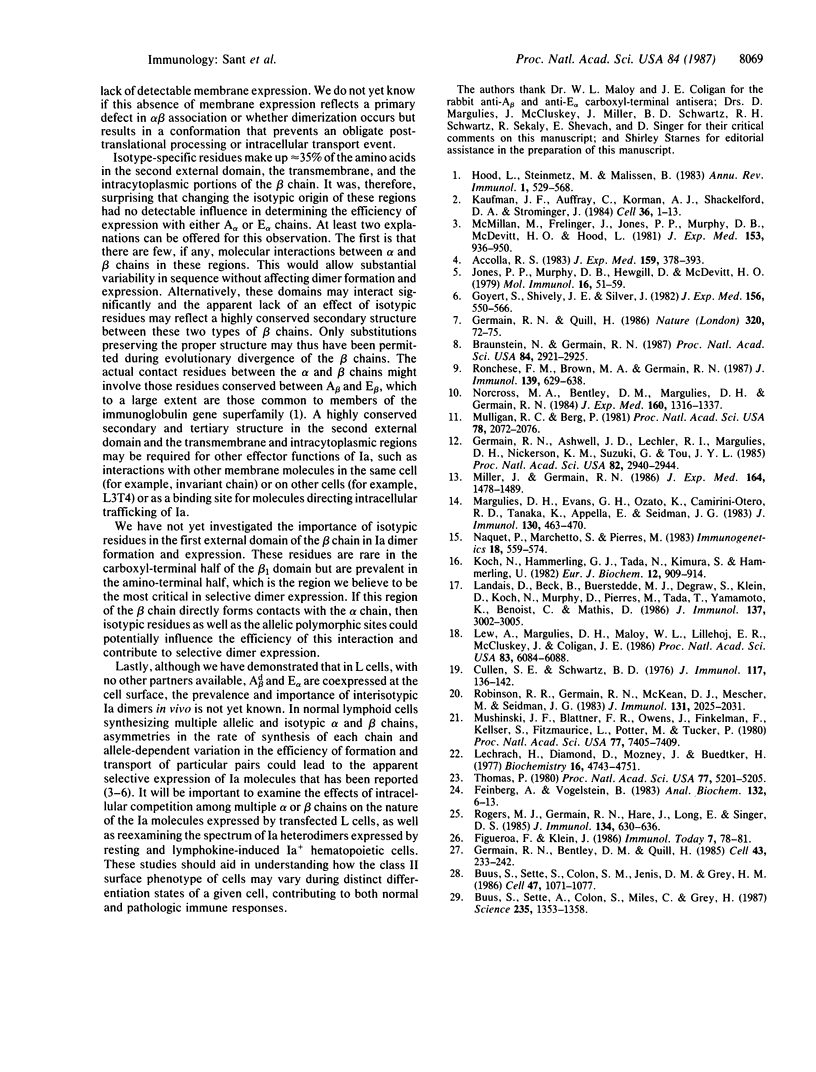Abstract
Cell surface expression of class II major histocompatibility complex-encoded (Ia) molecules depends on association of the component alpha and beta chains into a stable heterodimer. In the mouse, two isotypes of class II molecules have been identified, A beta A alpha and E beta E alpha. However, experiments from this laboratory have shown that, following DNA-mediated gene transfer into murine L cells, an A beta E alpha-mixed-isotype molecule can be assembled and expressed at the cell surface. In the present study, we have investigated the structural features of the beta chain that control the extent of association and level of membrane expression of A beta E alpha interisotypic pairs. The use of intact allelic A beta genes demonstrated that only A beta d chains, but not A beta b or A beta k chains, can be coexpressed on the surface membrane with E alpha chains. Transfection of recombinant A beta genes that encode all or half of the beta 1 domain from one allele and the rest of the chain from another allele revealed that the 5-7 polymorphic residues in the amino-terminal 50 residues of the A beta chain completely controlled this variation in expression with E alpha. Isotypically mixed beta genes encoding the A beta 1 domain of either A beta d or A beta k chains and the beta 2, transmembrane, and intracytoplasmic portions of E beta chains were used to assess the role of isotypically conserved structures in alpha beta pairing and expression. In marked contrast to the major alterations in expression accompanying changes in the amino-terminal polymorphic residues, exchange of these carboxyl-terminal isotypic segments had no detectable influence on the efficiency of expression with either A alpha or E alpha chains. These results argue strongly that variations in the efficiency with which distinct Ia alpha beta dimers assemble and are transported to the membrane is determined almost exclusively by a critical chain interaction involving the amino-terminal domains of the molecules.
Full text
PDF




Images in this article
Selected References
These references are in PubMed. This may not be the complete list of references from this article.
- Accolla R. S. Analysis of the structural heterogeneity and polymorphism of human Ia antigens. Four distinct subsets of molecules are coexpressed in the Ia pool of both DR1,1 homozygous and DR3,W6 heterozygous B cell lines. J Exp Med. 1984 Feb 1;159(2):378–393. doi: 10.1084/jem.159.2.378. [DOI] [PMC free article] [PubMed] [Google Scholar]
- Braunstein N. S., Germain R. N. Allele-specific control of Ia molecule surface expression and conformation: implications for a general model of Ia structure-function relationships. Proc Natl Acad Sci U S A. 1987 May;84(9):2921–2925. doi: 10.1073/pnas.84.9.2921. [DOI] [PMC free article] [PubMed] [Google Scholar]
- Buus S., Sette A., Colon S. M., Jenis D. M., Grey H. M. Isolation and characterization of antigen-Ia complexes involved in T cell recognition. Cell. 1986 Dec 26;47(6):1071–1077. doi: 10.1016/0092-8674(86)90822-6. [DOI] [PubMed] [Google Scholar]
- Buus S., Sette A., Colon S. M., Miles C., Grey H. M. The relation between major histocompatibility complex (MHC) restriction and the capacity of Ia to bind immunogenic peptides. Science. 1987 Mar 13;235(4794):1353–1358. doi: 10.1126/science.2435001. [DOI] [PubMed] [Google Scholar]
- Cullen S. E., Schwartz B. D. An improved method for isolation of H-2 and Ia alloantigens with immunoprecipitation induced by protein A-bearing staphylococci. J Immunol. 1976 Jul;117(1):136–142. [PubMed] [Google Scholar]
- Feinberg A. P., Vogelstein B. A technique for radiolabeling DNA restriction endonuclease fragments to high specific activity. Anal Biochem. 1983 Jul 1;132(1):6–13. doi: 10.1016/0003-2697(83)90418-9. [DOI] [PubMed] [Google Scholar]
- Germain R. N., Ashwell J. D., Lechler R. I., Margulies D. H., Nickerson K. M., Suzuki G., Tou J. Y. "Exon-shuffling" maps control of antibody- and T-cell-recognition sites to the NH2-terminal domain of the class II major histocompatibility polypeptide A beta. Proc Natl Acad Sci U S A. 1985 May;82(9):2940–2944. doi: 10.1073/pnas.82.9.2940. [DOI] [PMC free article] [PubMed] [Google Scholar]
- Germain R. N., Bentley D. M., Quill H. Influence of allelic polymorphism on the assembly and surface expression of class II MHC (Ia) molecules. Cell. 1985 Nov;43(1):233–242. doi: 10.1016/0092-8674(85)90028-5. [DOI] [PubMed] [Google Scholar]
- Germain R. N., Quill H. Unexpected expression of a unique mixed-isotype class II MHC molecule by transfected L-cells. Nature. 1986 Mar 6;320(6057):72–75. doi: 10.1038/320072a0. [DOI] [PubMed] [Google Scholar]
- Goyert S. M., Shively J. E., Silver J. Biochemical characterization of a second family of human Ia molecules, HLA-DS, equivalent to murine I-A subregion molecules. J Exp Med. 1982 Aug 1;156(2):550–566. doi: 10.1084/jem.156.2.550. [DOI] [PMC free article] [PubMed] [Google Scholar]
- Hood L., Steinmetz M., Malissen B. Genes of the major histocompatibility complex of the mouse. Annu Rev Immunol. 1983;1:529–568. doi: 10.1146/annurev.iy.01.040183.002525. [DOI] [PubMed] [Google Scholar]
- Jones P. P., Murphy D. B., Hewgill D., McDevitt H. O. Detection of a common polypeptide chain in I--A and I--E sub-region immunoprecipitates. Mol Immunol. 1979 Jan;16(1):51–60. doi: 10.1016/0161-5890(79)90027-0. [DOI] [PubMed] [Google Scholar]
- Kaufman J. F., Auffray C., Korman A. J., Shackelford D. A., Strominger J. The class II molecules of the human and murine major histocompatibility complex. Cell. 1984 Jan;36(1):1–13. doi: 10.1016/0092-8674(84)90068-0. [DOI] [PubMed] [Google Scholar]
- Koch N., Hämmerling G. J., Tada N., Kimura S., Hämmerling U. Cross-blocking studies with monoclonal antibodies against I-A molecules of haplotypes b, d and k. Eur J Immunol. 1982 Nov;12(11):909–914. doi: 10.1002/eji.1830121103. [DOI] [PubMed] [Google Scholar]
- Landias D., Beck B. N., Buerstedde J. M., Degraw S., Klein D., Koch N., Murphy D., Pierres M., Tada T., Yamamoto K. The assignment of chain specificities for anti-Ia monoclonal antibodies using L cell transfectants. J Immunol. 1986 Nov 1;137(9):3002–3005. [PubMed] [Google Scholar]
- Lehrach H., Diamond D., Wozney J. M., Boedtker H. RNA molecular weight determinations by gel electrophoresis under denaturing conditions, a critical reexamination. Biochemistry. 1977 Oct 18;16(21):4743–4751. doi: 10.1021/bi00640a033. [DOI] [PubMed] [Google Scholar]
- Lew A. M., Margulies D. H., Maloy W. L., Lillehoj E. P., McCluskey J., Coligan J. E. Alternative protein products with different carboxyl termini from a single class I gene, H-2Kb. Proc Natl Acad Sci U S A. 1986 Aug;83(16):6084–6088. doi: 10.1073/pnas.83.16.6084. [DOI] [PMC free article] [PubMed] [Google Scholar]
- Margulies D. H., Evans G. A., Ozato K., Camerini-Otero R. D., Tanaka K., Appella E., Seidman J. G. Expression of H-2Dd and H-2Ld mouse major histocompatibility antigen genes in L cells after DNA-mediated gene transfer. J Immunol. 1983 Jan;130(1):463–470. [PubMed] [Google Scholar]
- McMillan M., Frelinger J. A., Jones P. P., Murphy D. B., McDevitt H. O., Hood L. Structure of murine Ia antigens. Two dimensional electrophoretic analyses and high pressure liquid chromatography tryptic peptide maps of products of the I-A and I-E subregions and of an associated invariant polypeptide. J Exp Med. 1981 Apr 1;153(4):936–950. doi: 10.1084/jem.153.4.936. [DOI] [PMC free article] [PubMed] [Google Scholar]
- Miller J., Germain R. N. Efficient cell surface expression of class II MHC molecules in the absence of associated invariant chain. J Exp Med. 1986 Nov 1;164(5):1478–1489. doi: 10.1084/jem.164.5.1478. [DOI] [PMC free article] [PubMed] [Google Scholar]
- Mulligan R. C., Berg P. Selection for animal cells that express the Escherichia coli gene coding for xanthine-guanine phosphoribosyltransferase. Proc Natl Acad Sci U S A. 1981 Apr;78(4):2072–2076. doi: 10.1073/pnas.78.4.2072. [DOI] [PMC free article] [PubMed] [Google Scholar]
- Mushinski J. F., Blattner F. R., Owens J. D., Finkelman F. D., Kessler S. W., Fitzmaurice L., Potter M., Tucker P. W. Mouse immunoglobulin D: construction and characterization of a cloned delta chain cDNA. Proc Natl Acad Sci U S A. 1980 Dec;77(12):7405–7409. doi: 10.1073/pnas.77.12.7405. [DOI] [PMC free article] [PubMed] [Google Scholar]
- Naquet P., Marchetto S., Pierres M. Dissection of the Poly(Glu60Ala30Tyr10) (GAT)-specific T-cell repertoire in H-2Ik mice. II. The use of monoclonal antibodies to study the recognition of Ia antigens by GAT-reactive T-cell clones. Immunogenetics. 1983;18(6):559–574. doi: 10.1007/BF00345964. [DOI] [PubMed] [Google Scholar]
- Norcross M. A., Bentley D. M., Margulies D. H., Germain R. N. Membrane Ia expression and antigen-presenting accessory cell function of L cells transfected with class II major histocompatibility complex genes. J Exp Med. 1984 Nov 1;160(5):1316–1337. doi: 10.1084/jem.160.5.1316. [DOI] [PMC free article] [PubMed] [Google Scholar]
- Robinson R. R., Germain R. N., McKean D. J., Mescher M., Seidman J. G. Extensive polymorphism surrounding the murine Ia A beta chain gene. J Immunol. 1983 Oct;131(4):2025–2031. [PubMed] [Google Scholar]
- Rogers M. J., Germain R. N., Hare J., Long E., Singer D. S. Comparison of MHC genes among distantly related members of the genus Mus. J Immunol. 1985 Jan;134(1):630–636. [PubMed] [Google Scholar]
- Ronchese F., Brown M. A., Germain R. N. Structure-function analysis of the Abm12 beta mutation using site-directed mutagenesis and DNA-mediated gene transfer. J Immunol. 1987 Jul 15;139(2):629–638. [PubMed] [Google Scholar]
- Thomas P. S. Hybridization of denatured RNA and small DNA fragments transferred to nitrocellulose. Proc Natl Acad Sci U S A. 1980 Sep;77(9):5201–5205. doi: 10.1073/pnas.77.9.5201. [DOI] [PMC free article] [PubMed] [Google Scholar]




